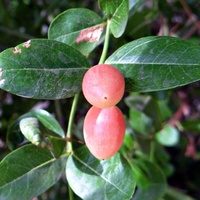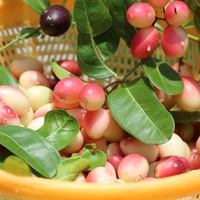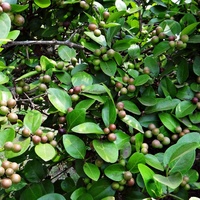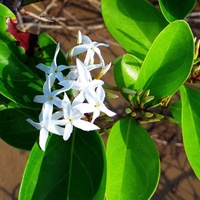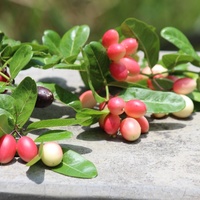Common name: Karonda
Other common names: Bengal currant, Christ's thorn
Description
Karonda or Bengal currant is a fruit-bearing shrub or small tree originating in India and Sri Lanka but now introduced and common in other warm climate countries, including Thailand, Malaysia, Australia, the southern United States, the Caribbean and parts of eastern Africa.
Left untended, it will climb up structures and to the top of trees up to 12 m (40 ft) tall. In cultivation, it is usually trimmed into a hedge or small shrub under 4 m (13 ft). The branches are many and wide-spreading, forming a thick, dense canopy, and they are armed with long sharp spines, arising singly or in pairs.
Leaves are elongated oval with a pointed tip, 3 to 6 cm (1.2 to 2.4 in) long, emerge red, then with age become dark glossy green on top and light dull green underneath. They are arranged in pairs along the stems and remain on the plant in all seasons. When cut or damaged, they exude a milky white latex, as do all plant parts.
The flowers are small and tubular with five white petals, occasionally pink-tinged. They are borne in rounded clusters and bloom throughout the year in tropical regions, peaking from spring through autumn. Pollination is by insects and moths, attracted to the flowers sweet fragrance, which is strongest at night.
Fruit are round or oval, 1 to 2.5 cm (0.5 to 1 in) long and in clusters of up to ten. Like the flowers, they are borne throughout the year in tropical regions. They have smooth, thin, yellowish skin with a pinkish blush when young, becoming red then dark purple to near black when ripe. The pulp is juicy, pink or red, tart to fairly sweet, berry-like in flavour and exudes droplets of latex which gives a somewhat bitter after-taste. Embedded in the pulp are between two and eight small brown seed.
Years ago, it was thought there were two distinct varieties, a red-fleshed sour variety and a pink-fleshed sweet variety. However, it is now determined that these differences are due to variations in the seedling population.
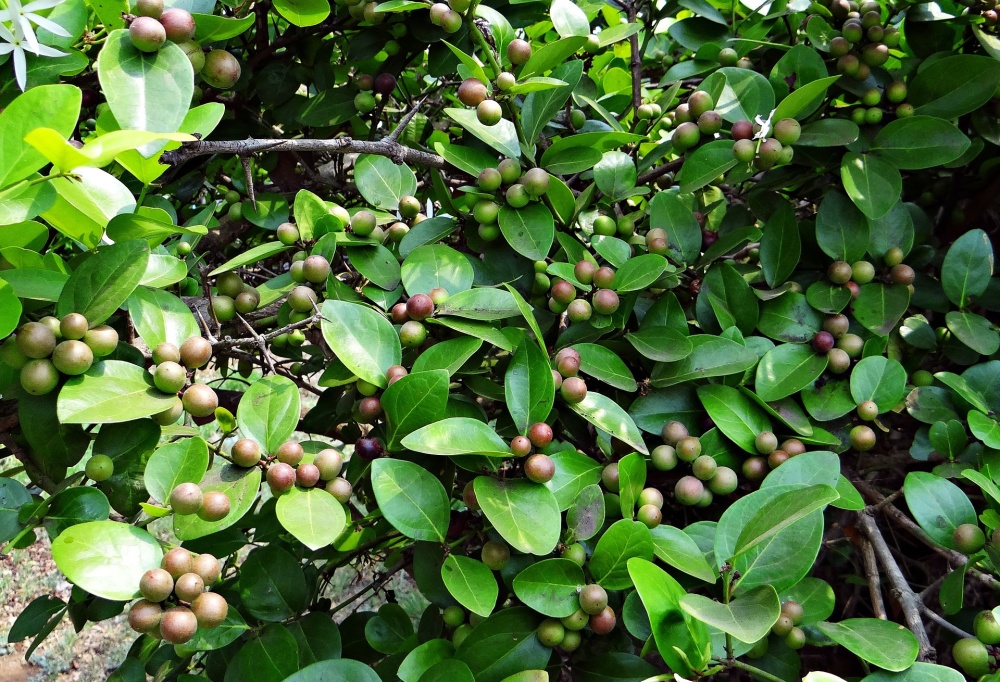
Image by Bishnu Sarangi from Pixabay
Use
In its native region and where introduced, it is cultivated mainly as a hedge plant. Still, the fruit are used for making cordials (syrups), chutneys, pickles and pies.
Fully ripe sourish fruit are cooked, usually with sugar and spices, such as Cloves (Syzygium aromaticum) and Cinnamon (Cinnamomum verum). The sweeter types are more often eaten fresh out-of-hand. They make a credible substitute for cooked apples used in apple pies, particularly where apples are imported, for example, in tropical regions.
The green or slightly underripe fruit are made into a pickle widely popular in India. The fruit are first washed, sliced in half, de-seeded, then fried in oil with mustard seeds, chillies and sometimes Turmeric (Curcuma longa). Afterwards, it is seasoned and sweetened to taste with salt and sugar then eaten straight away or stored away in sealed jars.
Climate
Grows naturally in dry to humid subtropical and tropical climates, generally frost-free areas with annual lows of 13 to 25°C, annual highs of 22 to 35°C, annual rainfall of 600 to 2500 mm, and a winter dry season of 2 to 7 months, extending to 12 months with irrigation or groundwater.
Growing
New plants are usually started from seed. However, there is significant variation in the colour and taste of fruit produced by seedling plants, which, until only recently, was thought due to varietal differences. For this reason, it is best to propagate plants vegetatively if for fruit production.
Performs best in free-draining clay-loam, loam, sandy-loam and loamy-sand soils of a moderately acid to alkaline nature, generally with a pH of 5.0 to 8.5, and on sites with full sun exposure. Will tolerate limestone soils. Flowering and fruiting are poor in permanently humid environments and on constantly moist soils.
Problem features
The sharp spines can inflict injury on the unwary.
Where it grows
References
Books
-
Allen, B. M. 1967, Malayan fruits : an introduction to the cultivated species, Donald Moore Press, Singapore
-
Dastur, J. F. 1964, Useful plants of India and Pakistan : a popular handbook of trees and plants of industrial, economic, and commercial utility, 2nd ed., D. B. Taraporevala Sons, Bombay
-
Krishen, P. 2006, Trees of Delhi : a field guide, Dorling Kindersley Publishers, Delhi
-
Macmillan, H. F. 1943, Tropical planting and gardening : with special reference to Ceylon, 5th ed, Macmillan Publishing, London
-
Martin, F. M., et al. 1987, Perennial edible fruits of the tropics : an inventory, U.S. Dept. of Agriculture (USDA), Agricultural Research Service, U.S. Government Printing Office (GPO), Washington, D.C.
-
Morton, J. F. & Dowling, C. F. 1987, Fruits of warm climates, Creative Resources Systems, Winterville, North Carolina
-
Page, P. E. 1984, Tropical tree fruits for Australia, Queensland Department of Primary Industries (QLD DPI), Brisbane
-
Parrotta, J. A. 2001, Healing plants of peninsular India, CABI Publishing, Wallingford, Oxfordshire
-
Randall, R. P. 2007, The introduced flora of Australia and its weed status, Cooperative Research Centre for Australian Weed Management, Glen Osmond, South Australia
-
Troup, R.S. & Joshi, H. B. 1975 to 1981, Silviculture of Indian Trees (3 volumes), Government of India Publications, New Delhi
Articles, Journals, Reports and Working Papers
-
Subhadrabandhu, S. 2001, Under-utilized tropical fruits of Thailand, Food and Agriculture Organisation of the United Nations (FAO), Regional Office for Asia and the Pacific (RAPA), Bangkok
